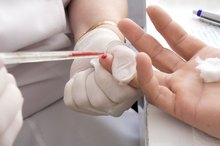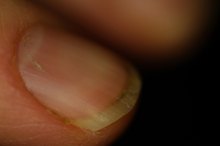What does fact checked mean?
At Healthfully, we strive to deliver objective content that is accurate and up-to-date. Our team periodically reviews articles in order to ensure content quality. The sources cited below consist of evidence from peer-reviewed journals, prominent medical organizations, academic associations, and government data.
- MayoClinic.com: Anemia: Symptoms
- MayoClinic.com: Treatments
- Medline Plus: Chronic Lymphocytic Leukemia
- Medline Plus: Pneumonia
The information contained on this site is for informational purposes only, and should not be used as a substitute for the advice of a professional health care provider. Please check with the appropriate physician regarding health questions and concerns. Although we strive to deliver accurate and up-to-date information, no guarantee to that effect is made.
Are Night Sweats & Weight Loss Symptoms of Anemia?
Anemia is a result of not having enough red blood cells to carry oxygen to your tissues. You can develop anemia for a variety of reasons, but you can also take certain precautions to decrease the risk of developing this condition. Depending on the cause of anemia, you may need to take supplements or injections or may require surgery to correct the problem.
If you are experiencing serious medical symptoms, seek emergency treatment immediately.
Symptoms of Anemia
Since an array of conditions can cause anemia, your symptoms may vary slightly, but the condition in general does have similar symptoms 1. You may not have symptoms right away when you develop anemia, and your symptoms can become more severe the longer your condition goes untreated 1.
Causes of Anemia
Facts About Low Potassium & Low Iron
Learn More
Poor diet and lack of certain vitamins and minerals such as iron, folic acid and vitamin B12 can cause anemia. Certain conditions, such as sickle cell anemia, aplastic anemia and anemia caused by chronic disease or bone marrow disease, can cause various types of anemia and require different treatments. Some medications can deplete certain vitamins and minerals from your system and lead to anemia. Dialysis and other conditions can also affect how your body absorbs iron and may lead to anemia.
- Poor diet and lack of certain vitamins and minerals such as iron, folic acid and vitamin B12 can cause anemia.
- Dialysis and other conditions can also affect how your body absorbs iron and may lead to anemia.
Other Causes of Night Sweats and Weight Loss
While anemia does not cause weight loss, weight loss could cause anemia. If you’re eating a poor diet, lacking vitamins and minerals, you can develop anemia. Anemia does not cause night sweats, but there are some conditions, such as chronic lymphocytic leukemia, that can cause both night sweats and weight loss 5. Medications used to treat chronic pain also can cause both conditions, and so can conditions such as pneumonia.
- While anemia does not cause weight loss, weight loss could cause anemia.
- Anemia does not cause night sweats, but there are some conditions, such as chronic lymphocytic leukemia, that can cause both night sweats and weight loss 5.
Considerations
Iron Dosages for Anemia With Bruising
Learn More
If you begin to experience night sweats, weight loss or signs of anemia, consult with your physician about the possible cause of your symptoms 1. Ignoring these symptoms could allow your condition to become worse. Do not attempt to treat any undiagnosed conditions at home, which could worsen your symptoms. Even if your doctor has given you a proper medical diagnosis, do not take any supplements or vitamins without physician approval. It is possible to overdose on iron, which could cause symptoms such as constipation, headache and nausea.
- If you begin to experience night sweats, weight loss or signs of anemia, consult with your physician about the possible cause of your symptoms 1.
- Do not attempt to treat any undiagnosed conditions at home, which could worsen your symptoms.
Related Articles
References
- MayoClinic.com: Anemia: Symptoms
- MayoClinic.com: Treatments
- Drugs.com: Iron Deficiency
- Drugs.com: Cymbalta Side Effects
- Medline Plus: Chronic Lymphocytic Leukemia
- Medline Plus: Pneumonia
- Rabel A, Leitman SF, Miller JL. Ask about ice, then consider iron. J Am Assoc Nurse Pract. 2016;28(2):116-20. doi:10.1002/2327-6924.12268
- Schnuelle P, Oberheiden T, Hohenadel D, et al. An unusual case of severe iron deficiency anaemia. Gut. 2006;55(7):1060. doi:10.1136/gut.2006.094680
- Robinson KJ, Sanchack KE. Palpitations. StatPearls Publishing. Updated March 26, 2019.
- Berliner D, Schneider N, Welte T, Bauersachs J. The Differential Diagnosis of Dyspnea. Dtsch Arztebl Int. 2016;113(49):834-845. doi:10.3238/arztebl.2016.0834
- Park MY, Kim JA, Yi SY, Chang SH, Um TH, Lee HR. Splenic infarction in a patient with autoimmune hemolytic anemia and protein C deficiency. Korean J Hematol. 2011;46(4):274-8. doi:10.5045/kjh.2011.46.4.274
- Rodriguez NM, Shackelford KS. Pernicious Anemia. StatPearls Publishing. Updated April 10, 2019.
- Pittman RN. Chapter 7, Oxygen Transport in Normal and Pathological Situations: Defects and Compensations. In: Regulation of Tissue Oxygenation. San Rafael (CA): Morgan & Claypool Life Sciences; 2011.
- Moore CA, Krishnan K. Aplastic Anemia. StatPearls Publishing. Updated May 14, 2019.
- Alder L, Tambe A. Acute Anemia. StatPearls Publishing. Updated April 24, 2019.
- American Society of Hematology. Anemia and Pregnancy.
- Kumar KJ, Asha N, Murthy DS, Sujatha M, Manjunath V. Maternal anemia in various trimesters and its effect on newborn weight and maturity: an observational study. Int J Prev Med. 2013;4(2):193-9.
- Andres E, Serraj K. Optimal management of pernicious anemia. J Blood Med. 2012;3:97-103. doi:10.2147/JBM.S25620
- Wassef A, Nguyen QD, St-andré M. Anaemia and depletion of iron stores as risk factors for postpartum depression: a literature review. J Psychosom Obstet Gynaecol. 2019;40(1):19-28. https://doi.org/10.1080/0167482X.2018.1427725
- Hurtado EK, Claussen AH, Scott KG. Early childhood anemia and mild or moderate mental retardation. Am J Clin Nutr. 1999;69(1):115-9. doi:10.1093/ajcn/69.1.115
- Anemia | MedlinePlus. Medlineplus.gov.
- Anemia and Pregnancy. American Society of Hematology.
- Your Guide to Anemia. National Heart, Lung, and Blood Institute.
- Iron-Deficiency Anemia | National Heart, Lung, and Blood Institute (NHLBI). Nhlbi.nih.gov.
- Pernicious Anemia | National Heart, Lung, and Blood Institute (NHLBI). Nhlbi.nih.gov.
- Sutherland S, OʼSullivan D, Mullins J. An Association Between Anemia and Postpartum Depression [35C]. Obstetrics & Gynecology. 2018;131:39S. DOI:10.1097/01.aog.0000532975.79181.b6
Writer Bio
Derek Buckner has been writing professionally since 2005, specializing in diet, nutrition and general health. He has been published in "Today's Dietitian," "Food Essentials" and "Eating Well Magazine," among others. Buckner is a registered dietitian and holds a Bachelor of Science in nutrition and food science from Drexel University.









